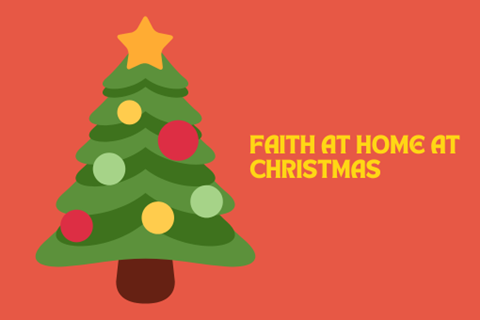
Registered users only: Download as a PDF here.
One way to do this is to protect family time by saying no to things we’re invited to. Christmas events are not compulsory! Just because they are fun, good or local doesn’t mean we have to go. I know this is hard, but wouldn’t it be amazing to plan in advance the faith focus you would like to have as a family this Christmas, and choose to say yes only to events that contribute to this goal?
If this sounds like a crazy idea, you could come at it from the opposite direction. Knowing that your calendar is already filling up, mark out some blocks of time in December to do faith-building activities together. This might be a ten-minute space in the morning, in the evening after dinner, or on a Saturday afternoon early in December.
However you do it, you are more likely to achieve what you are aiming for if you are intentional about it. Write down your goals, prioritise them, share them together and review them. You could call a family meeting to discuss what you would like to do during Advent, what you would like to keep the same or change from last year and how you would like to purposefully celebrate Jesus.
As well as things I’m planning intentionally, I also have a list of ‘things we could do’. Most of these fall into the ‘happy holidays’ tradition: things that are not faith-focused but give us time as a family to have fun and do things together, which in itself is good for growing faith. Just creating space to be together and do things together allows us to share our faith together. I try to collect the things together that we will need for these activities (often baking or craft for us), which means that if we have a slot we can just choose an activity and then off we go. But it’s also fine if these things don’t happen. This gives me space to enjoy Christmas activities without feeling guilty about not getting things done.
What could you do?
Whenever families ask me what they could do at home to boost faith formation at home, I encourage them to do things that suit their family, adding a faith element into activities they already do and strategically choosing one or two new things to add a faith element they want to build.
Do things that suit your family
It’s easy to try to live out someone else’s faith or to do what we imagine others are doing. Faith at home becomes a way that we live when we do things that suit our family. I have friends who use a family devotional at Christmas, which I really like the sound of. However, this continues a pattern that they follow most weeks throughout the year, so it totally fits with the rhythm they’ve created in their home. Our home is more suited to stories, so we read a chapter of a Christmas story each night.
We need to bear in mind the season our families are currently in. When my children were under 5 I didn’t read them chapter books. Instead, I wrapped up 24 Christmas-linked picture books, then we opened one each day and read it together. When my children are teenagers, maybe we will listen to a podcast together (or whatever exists in that future world!).
When they were very small, I bought a simple Nativity set they could play with, throw and chew. Now they are older we have a lovely hand-carved wooden one and a Playmobil one. (Who am I kidding? We have about ten! But that’s for me to discuss at my next Nativity Sets Anonymous meeting!)
Our lifestyles change how we do things. Are you usually very busy at the weekend? If so, don’t plan big events at those times. Or are you busier during the week? If that’s the case, plan your extra thing at the weekend. Do you always have music on at home? If so, create a Christmas playlist, or a different one for each week of December, and enjoy some glorious worship, carols and silly Christmas songs together. Do you love ritual, quiet and candlelight? If that’s the case, stock up on candles and pick a great prayer you can use together during Advent.
Bring a faith element into existing activities
Often the easiest way to bring faith to the forefront is to include Jesus in something we already do. Obviously, he’s already there, but this is about us consciously doing things to enrich our faith.
This might be decorating your Christmas tree as usual, then all pausing for a minute before you put the star or angel on the top. Reflect on the year, give thanks for your three favourite things in 2019 or ask God to help you put him at the top of your list this season.
It could be decorating your house as usual, but adding some decorations that specifically relate to the Christmas story, such as angels or stars. We love making angel bunting, using A3 paper to make giant angel paper dolls. We have also done angel-topped jam tarts and angel-stamped homemade wrapping paper using a cookie cutter and red paint on lining paper.
It could be making a gingerbread house into a gingerbread stable. The IKEA one converts really well by leaving off one side and turning the chimney into a manger (seegodventure.co.uk/news/gingerbread-nativity-scene-using-an-ikea-kit for details).
Strategically include things to add a faith element
What you want to build into your faith at home is likely to be influenced by your spiritual style. You may not have thought a lot about your faith style, because it’s likely that many of your Chris-tian friends will share a similar one. But ask yourself whether you prefer to learn scripture or sing worship songs. Would you rather get involved in social justice activities or invite friends to events? Do you like looking at Christian art or studying the cultural background to Bible stories?
All of these are great, but some will appeal more than others. Whichever you are drawn to, find a way to do them in a special way during Advent. You could learn the Magnificat by heart, find a new Christmas worship album, sign up to help a social outreach project in your area, pray about which of your friends to invite to various Christmas events at your church, collect some beautiful Christmas art to use as a reflection or collect some great non-fiction books to explore the cultural backdrop of the Nativity story. Don’t do all of them; just pick one!
Another way to think about adding elements to your faith at home life is to think about what your family does without thinking, and which elements might need a bit of a boost. What do you find works most easily in your routine: Bible reading or serving others? Worshiping God together or sitting quietly with him individually? The Bridger model of faith talks about faith as understanding, faith as imagining, faith as trusting and faith as doing. Which of these is your family great at? Which could you work on a bit this Advent?
Whatever you choose, do it strategically and intentionally. Be realistic and have fun with it! Making a faith at home plan isn’t another chance to compare yourself with others or beat yourself up about not doing it well. It’s a chance to move further along in the faith you have, and this is a lifelong journey. And as I have to tell myself when I’m tempted to plan too much, there will be another Christmas next year!
Supporting documents
Click link to download and view these files1016562.pdf
PDF, Size 0.71 mb




























